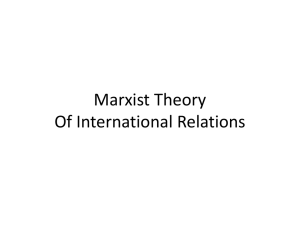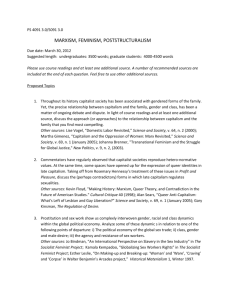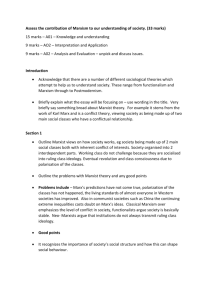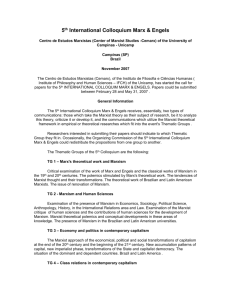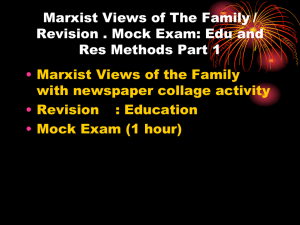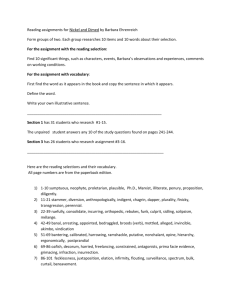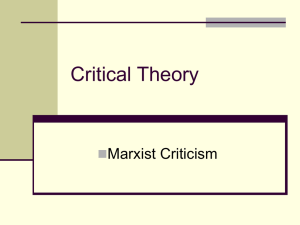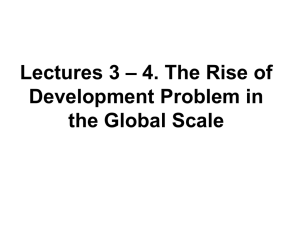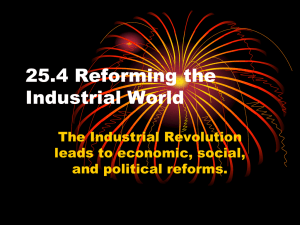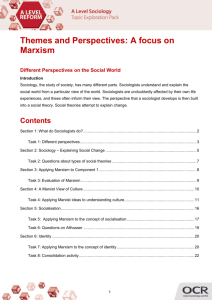Chapter 8 Summary (English)
advertisement
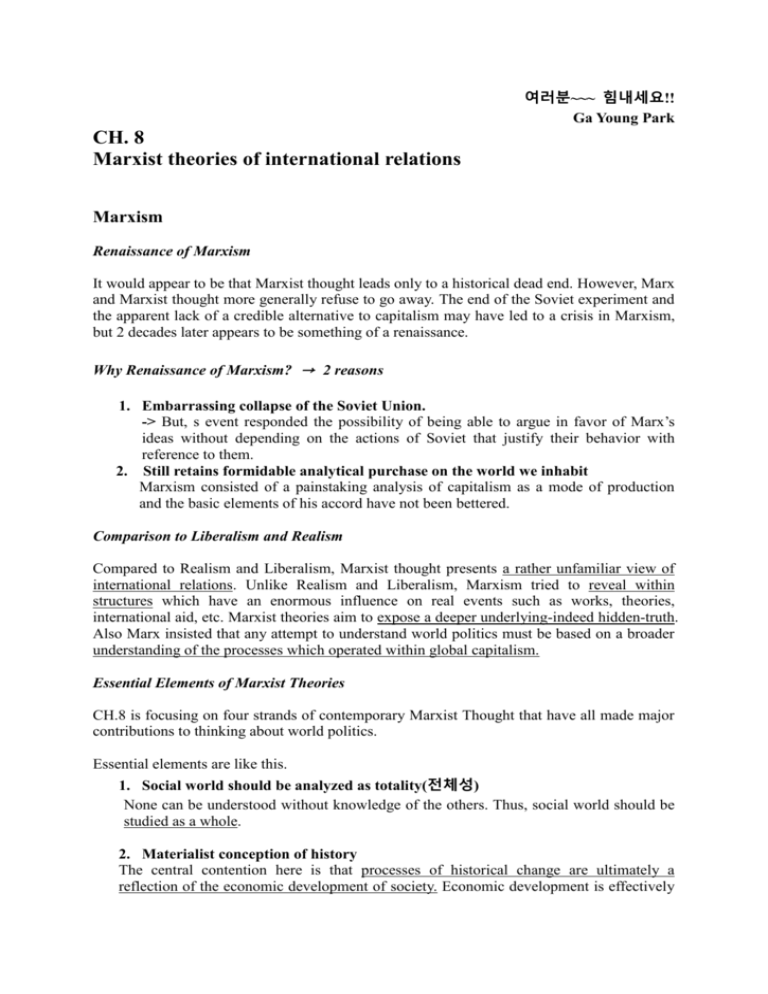
여러분~~~ 힘내세요!! Ga Young Park CH. 8 Marxist theories of international relations Marxism Renaissance of Marxism It would appear to be that Marxist thought leads only to a historical dead end. However, Marx and Marxist thought more generally refuse to go away. The end of the Soviet experiment and the apparent lack of a credible alternative to capitalism may have led to a crisis in Marxism, but 2 decades later appears to be something of a renaissance. Why Renaissance of Marxism? → 2 reasons 1. Embarrassing collapse of the Soviet Union. -> But, s event responded the possibility of being able to argue in favor of Marx’s ideas without depending on the actions of Soviet that justify their behavior with reference to them. 2. Still retains formidable analytical purchase on the world we inhabit Marxism consisted of a painstaking analysis of capitalism as a mode of production and the basic elements of his accord have not been bettered. Comparison to Liberalism and Realism Compared to Realism and Liberalism, Marxist thought presents a rather unfamiliar view of international relations. Unlike Realism and Liberalism, Marxism tried to reveal within structures which have an enormous influence on real events such as works, theories, international aid, etc. Marxist theories aim to expose a deeper underlying-indeed hidden-truth. Also Marx insisted that any attempt to understand world politics must be based on a broader understanding of the processes which operated within global capitalism. Essential Elements of Marxist Theories CH.8 is focusing on four strands of contemporary Marxist Thought that have all made major contributions to thinking about world politics. Essential elements are like this. 1. Social world should be analyzed as totality(전체성) None can be understood without knowledge of the others. Thus, social world should be studied as a whole. 2. Materialist conception of history The central contention here is that processes of historical change are ultimately a reflection of the economic development of society. Economic development is effectively the motor of history. Tension between the means of production and relations of production forms economic base. 생산관계가 새로운 생산수단을 보다 더 잘 수용하기 위해 변형되는 사회변화과정으로 연결 Development in the Economic Base -> determines the mode of production of material life conditions the social, political, and intellectual life process in general. -> Thus, ultimately it leads to change in legal and political superstructure. 3. Class In contrast to Liberalist, who believes that there is an essential harmony of interest b/w various groups, Marxist believes that society is systemically prone to class conflict. “The history of all hitherto existing societies is the history of class struggle” In capitalist society, the main axis of conflict is b/w bourgeoisie and the proletariat. Marxists argued that only analyze the world system is not desirable; the point is to change it. Marx was committed to the cause of emancipation(해방). He was not interested in developing an understanding of dynamic of capitalist society simply for the sake of it. Rather, he expected such an understanding to make it easier to over throw the prevail order and replace it with a communist society. Critical Theory Critical theory has its roots in the work of the Frankfurt School. Critical Theory and Gramscianism -> hard to distinguish, why? Robert W. Cox refers to his own Gramsci-influenced approach as critical theory. Both Gramscinanism and critical theory has their roots in Western Europe of the 1920~30s Differences? Gramsci tended to be much more concerned with issues relating to the subfield of international political economy than critical theory. Critical theory tended to concerned more on international society, international ethics and security. Key features 1. Their intellectual concerns are rather different from those of most other Marxists interested in the further development of analysis of the economic base of society. Concentrated on questions relating to culture, bureaucracy, the social basis and nature of authoritarianism, the structure of the family, and on exploring such concepts as reason and rationality. 2. Highly dubious as to whether the proletariat in contemporary society does in fact embody the potential for emancipator transformation in the way that Marx has believed One-dimensional society: society to which the vast majority simply cannot begin to conceive an alternative. 노동자 계급은 단순하게 체제에 의해 흡수, 더 이상 체제에 대한 위협 을 대표하지 못한다. 3. Emancipation a key concern of Marxist thinkers, (but the meaning that they give to the term is often very unclear and deeply ambiguous. 해방 뿐 아니라 해방을 요구하는 인간의 용량과 능력 강조 Under the name of Imperialism and Stalinism barbaric behavior have been justified. The first generation of Critical Theorist Emancipation through ‘reconciliation with nature’ In contrast with traditional Marxism that emphasized the kind of mind-set that is required for conquering nature and domination of human being. The second generation of Critical Theorist More concerned with communication than with our relationship with the nature. . Habermas The route to emancipation lies through radical democracy : Widest possible participation is encouraged not only in word but also in deed, by actively identifying barriers to participation and overcoming them. Participation is not to be confined within the borders of a particular sovereign state. Rights and obligations extend beyond state frontiers. Andrew Linklater He has used some of the key principles and precepts developed in Habermass’s work in order to argue that emancipation in the realm of international relations should be understood in terms of the moral boundaries of a political community. Emancipation with a process in which the borders of the sovereign state lose their ethical and moral significance. Development of EU representing a progressive or emancipator tendency in an important part of the int’l system is entering an era in which the sovereign state, which has for so long lose some of its pre-eminence. Gramscianism Drawing upon the work of Antonio Gramsci for inspiration, writers within an ‘Italian’ school of International Relations have made a considerable contribution to thinking about world politics. Hegemony Gramsci focused more on superstructural phenomena, and he explored the processes by which consent for a particular social and political system was produced and reproduced and through the operation of hegemony. 체제는 강제력(coercion)뿐 아니라 합의(consensus)에서도 유지되는 것이다. The hegemony of the ruling class is a key element in the perpetuation of its dominance. Hegemony allows the ideas and ideologies of the ruling stratum to become widely dispersed, and widely accepted throughout society. Society could only be transformed when the hegemonic position is successfully challenged! (Hegemony vs Conterhegemony) Robert Cox “Theory is always for someone and for some purpose” If ideas and values are a reflection of a particular set of social relations, and are transformed as those relations are themselves transformed, then this suggest that all knowledge must reflect a certain context, a certain time, a certain space. No value free ideas! Knowledge cannot be objective and timeless in a sense that some contemporary realists claim. Theories such as realism and liberalism are for or serve the interests of those who prosper under the prevailing order that is the inhabitants of the developed states and in particular the ruling elites. Realists-> describes world as it is, as it always will be, however, what they are really doing is reinforcing the ruling hegemony in the current world order. Hegemony Important! In a sense that maintain stability and continuity here as it at the domestic level. 지배적 권력은 그들의 이익에 맞도록 세계 질서를 형성해 왔다. 심지어 기존 질서에 의해 불이익 을 감당하고 있는 이들로부터도 그러한 질서에 대한 광범위한 동의 끌어냈다. Ex) Free trade: can be viewed as a hegemonic idea Free trade benefits everybody has been widely accepted that it has attained “commonsense:” status. This system is very much in interests of the hegemonic idea. However, it benefits for peripheral states far less apparent. World-system theory The origins of world-system theory World-system theory can be seen as a direct development of Lenin’s work on imperialism and the Latin American Dependency School.. Monopoly capitalism Lenin argued that since after 1867 the character of capitalism had changed. Capitalism had entered a new stage-its highest and final stage- with the development of monopoly capitalism. Under Monopoly capitalism – two tier structures had developed within the world economy dominant (core) and less developed(periphery) No longer an automatic harmony of interests b/w all workers. The capitalists of the core could pacify their own working class through the further exploitation of the periphery. The Key features of Wallerstein’s world-system theory For him history has been marked by the rise and demise of a series of world systems. The hidden driving force- capitalism All the institutions of the social world are continually being created and re-created. The system itself is historically bounded. It had a beginning, has a middle and will have an end. Interrelationship in the world-economy In terms of the geography of the modern world-system, in addition to a Core- periphery distinction + semi-periphery (Wallerstein added) Together, the core, semi-periphery, and periphery make up the geographic dimension of the world economy. * Semi-periphery : Intermediate role within the world system. It has its own relatively vibrant indigenously owned industrial base. Providing source of labor that counteracts any upward pressure on wages in the core & a new home for those industries that can no longer function profitably in the core. Stabilizing the political structure of the world system. The rich get richer while the poor become poorer. Why? ? According to world system theorists, the three zones of the world economy are linked together in an exploitative relationship in which wealth is drained away from the periphery to the center. As a consequence, the relative positions of the zones become ever more deeply entrenched. Temporal dimensions of Wallerstein’s description of the world-economy : Cyclical rhythm, secular trends, contradiction, and crisis. 1. Cyclical rhythm CapitalismRecurrent periods of expansion (boom) and contradiction (bust) 2. Secular trend Long term growth or contraction of the world-economy 2. Contradiction ‘constraints imposed by systemic structures which make one set of behavior optimal for actors in the short run and a different, even opposite, set of behavior optimal for the same actors in the middle run’ One of the contradiction -> The crisis of underconsumption 3. Crisis Refers to a very specific temporal occurrence. Crisis constitutes a unique set of circumstances that can only be manifested once in the lifetime of a world system. Occurs when? the contradictions, secular trends, and cyclical rhythms combine in such a way as to mean that the system cannot continue to reproduce itself. New Marxism Derive their ideas more directly from Marx’s own writings returning to the fundamental tenets of Marxist thought and sought to reappropriate ideas. Justin Rosenburg – Capitalism and global social relations Justin Rosenburg focuses on the characters of the international system and its relationship to the charging character of social relations. His starting point is a critique of Realist International Relations theory. 1. The character of the int’l system in each period was completely different. -> Realists’ essentially timeless account of int’l relations by analysis of the differences in the character of int’l relations by Greek and Italian examples. International system as autonomous, entirely political realms As an alternative, he argues for the development of a theory of international relations that is sensitive to the changing character of world politics. Theory must also recognize that international relations are part of a broader pattern of social relations. The form of the state will be different under different modes of production and as a result for characteristics of inter-state relations will also vary. Benno Teschke – social property relations For Benno Tesschke, the study of social property relations provides the means for means for analyzing the key elements of international relations, and the transitions between one international relations, and the transition between one international system and another.
